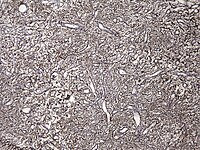
Photo from wikipedia
Rationale: Solitary fibrous tumors are mesenchymal tumors presenting as fibroblastic neoplasms with prominent branching vascular patterns, which are often generated from the pleura. Most solitary fibrous tumors are benign; however,… Click to show full abstract
Rationale: Solitary fibrous tumors are mesenchymal tumors presenting as fibroblastic neoplasms with prominent branching vascular patterns, which are often generated from the pleura. Most solitary fibrous tumors are benign; however, some can turn malignant. High-grade sarcomas from solitary fibrous tumors include multidirectional histopathological components. Patient concerns: We describe our experience of a giant high-grade sarcoma with mixed components generated from a solitary fibrous tumor of the pleura in a 67-year-old female patient presenting with cough and left-sided chest pain. The patient had been diagnosed with a pleural mass in the left chest by X-ray about 30 years earlier. However, the tumor was allowed to grow, without surgical intervention, for a long time. Interventions: Thoracic surgeons performed the removal of the giant pleural tumor; the tumor measured 18.0 × 14.5 × 10 cm in size, and was considered a giant tumor generated from the pleura of the left chest cavity. Diagnoses: The surgically removed tumor was solid and light brownish, and included myxoid and arabesque pattern lesions. The tumor also showed hemorrhagic and necrotic lesions. Moreover, spindle cells with less atypia, resembling fibroblasts, were noted. These spindle tumor cells were CD34- and Stat6-positive, suggesting a solitary fibrous tumor. Some of the spindle tumor cells were surrounded by thick collagenous fibers. Considering that the tumor originated from the parietal pleura, the tumor was defined as a solitary fibrous tumor in origin. The tumor also comprised high-grade sarcomatous components; these included lipid-rich, rhabdomyosarcomatous, and pleomorphic components. The high-grade sarcoma component included bizarre tumor cells with severe atypia. Outcomes: Tumor recurrence occurred in the left chest about 4 months after the surgery, and the patient died 8 months postoperatively. Lessons: The present case clearly demonstrates that a solitary fibrous tumor can develop into high-grade sarcomatous overgrowth, including lipid-rich, rhabdomyosarcoma, and pleomorphic sarcoma components, if left untreated for a prolonged period. This case provides profound insights about the natural history, histogenesis, differentiation, and malignant transformation of solitary fibrous tumors.
Journal Title: Medicine
Year Published: 2017
Link to full text (if available)
Share on Social Media: Sign Up to like & get
recommendations!